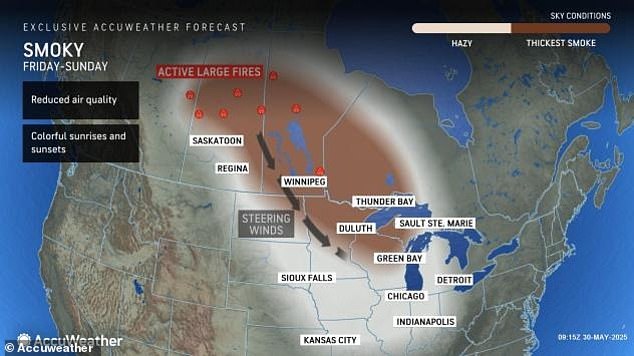
Toxic Chemicals Trigger Air Emergency: Millions Urged to Close Windows Immediately
Air Quality Alerts Issued as Canadian Wildfire Smoke Spreads Across U.S.
Millions of Americans in the Midwest and Plains are under air quality alerts as toxic smoke from Canadian wildfires drifts south. Minnesota, Michigan, Wisconsin, North Dakota, and Illinois have urged residents to close windows and limit outdoor activities. The smoke, originating from over 160 active fires in British Columbia, Saskatchewan, Manitoba, and Alberta, may cause air pollution levels deemed “unhealthy for all” in some areas.
[Image: Satellite map showing smoke drifting from Canada into the U.S. Midwest.]
Caption: Smoke from Canadian wildfires blankets parts of the northern U.S.
Health Warnings and Precautions
The Minnesota Pollution Control Agency advised reduced outdoor activity, closed windows, and minimized vehicle use. The National Weather Service recommended using air conditioning to filter indoor air. While the smoke is expected to linger through the weekend, officials note this event is less severe than 2023’s historic wildfires, which turned East Coast skies orange.
Regional Impacts
- Midwest/Plains: Heavy smoke concentrations are likely in the Dakotas, Minnesota, and Iowa. Cities like Fargo, Minneapolis, and Chicago may see reduced air quality.
- Great Lakes: Michigan warned of “unhealthy” pollution levels for sensitive groups, with potential short-term spikes affecting all residents.
- Northeast: Hazy skies may reach the Mid-Atlantic, though impacts remain uncertain.
Meteorologist Brandon Buckingham noted smoke could dim sunlight, create vivid sunsets, and reduce visibility. Lower-level smoke may worsen respiratory issues and travel safety.
[Image: Residents in Manitoba evacuating as wildfires rage nearby.]
Caption: Over 17,000 people evacuated in Manitoba due to wildfires.
Canadian Wildfire Crisis
Canada’s wildfire season has already burned 1.6 million acres, prompting Manitoba to declare a state of emergency—its largest evacuation in decades. Alberta also faces disruptions, with oil production halted and communities like Chipewyan Lake evacuating. While less destructive than 2023’s record 45 million-acre burn, the ongoing fires highlight escalating climate-driven risks.
2023 Comparison
Last year’s fires choked U.S. cities, with New York City’s air quality hitting 56 times the WHO’s safety limit. Similar alerts swept from Massachusetts to the Carolinas. Current conditions remain less severe, but experts urge vigilance as dry, hot weather may worsen ozone pollution.
[Image: 2023 photo of New York City shrouded in orange haze.]
Caption: NYC’s 2023 air quality crisis linked to Canadian wildfires.
Looking Ahead
Smoke is expected to linger into next week, with northern states most affected. Authorities continue monitoring shifts in wind patterns and fire activity. Residents in at-risk areas should stay updated on air quality indexes and adhere to safety guidelines to minimize health risks.
—Report includes data from the Minnesota Pollution Control Agency, AccuWeather, and Canadian officials.


